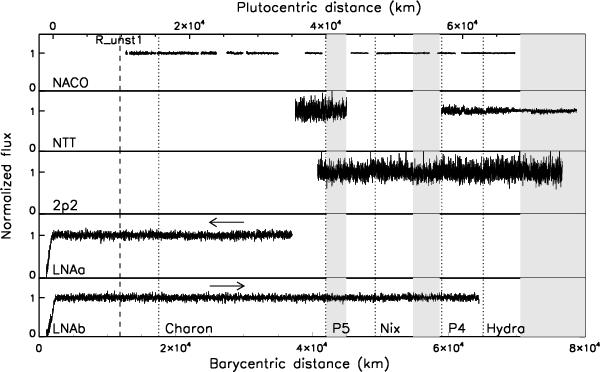Fig. 3

Normalized flux-versus-distance light curves, where unity corresponds to the unocculted stellar flux, and the zero level corresponds to the complete star disappearance. The successive positions of the occulted stars on the sky have been projected into Pluto’s equatorial plane, relative either to Pluto’s center (lower scale) or to the system barycenter (upper scale). From top to bottom: NACO (note the interruptions in the observation); La Silla/NTT; La Silla/2.2 m; Pico dos Dias (LNA) before the occultation by Pluto; Pico dos Dias (LNA) after the occultation by Pluto (the arrows indicate the direction of time). The satellites’ distances are taken from Tholen et al. (2008) for Charon, Nix and Hydra, and from Showalter et al. (2011, 2012) for P4 and P5, and are indicated by the vertical dotted lines. The radii Runst,S (in Plutocentric distance, dashed line) is the boundary inside which stable S-orbits can exist around Pluto (Nagy et al. 2006). Grey zones are regions of stability allowed by Nix and Hydra (Pires Dos Santos et al. 2011).
Current usage metrics show cumulative count of Article Views (full-text article views including HTML views, PDF and ePub downloads, according to the available data) and Abstracts Views on Vision4Press platform.
Data correspond to usage on the plateform after 2015. The current usage metrics is available 48-96 hours after online publication and is updated daily on week days.
Initial download of the metrics may take a while.


